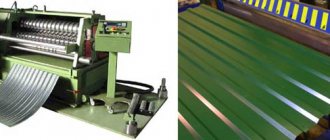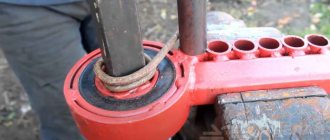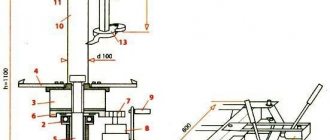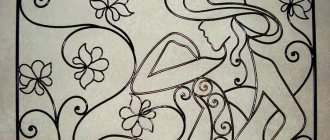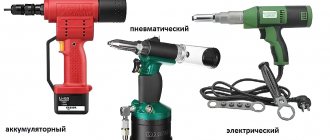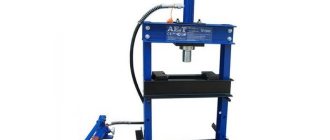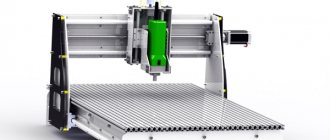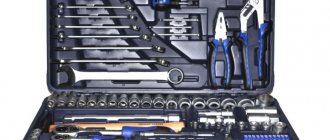Sale of bending machines with a discount of up to 5%. Availability of machines in warehouse in Moscow. More than 40 representative offices in Russian cities. Delivery of machines from 2 days to 2 weeks
It is probably difficult to find a metal structures production facility that does not have bending equipment. After all, with the help of manual bending machines you can perform a large number of operations, such as: bending, rolling, profiling, cutting, reinforcing various metal rods and pipes. This equipment is simply necessary in forge shops, on construction sites and at various metalworking enterprises.
Let's take a closer look at manual bending machines and, based on the information provided, you can make the right choice. Flanging machines.
These machines are also called edge bending machines. Using this equipment, it becomes possible to roll, bend, profile and reinforce sheet material. Flanging machines are used when performing roofing work and when installing ventilation systems.
Typically, edge bending machines are quite compact and you can easily secure them to your workbench using a clamp. The material is processed by 2 rollers of different diameters and the same profile, and the part is rolled between them.
Ease of use lies in the mobility of flanging machines; due to their low weight, they can be moved from one construction site to another. You can work on the machine without connecting it to the network.
Operating principle of a manual sheet bender
The sheet metal is placed on the work table and secured with a pressure beam (crossbeam). Then the rotary beam bends the workpiece to the desired angle. If necessary, the sheet is cut with a knife, which moves along guides along the length of the sheet bending machine.
Depending on the production tasks, the capabilities of the sheet bender can be expanded if you buy additional accessories: a folding machine, a support table, a protractor, a bending angle limiter, a cutting machine, etc.
Advantages and disadvantages
A manual machine for the production of corrugated sheets is often purchased by both small private companies and large industrial holdings. These statistics suggest that such units have a number of significant advantages. And if there are any disadvantages, they are more than offset by the advantages.
Advantages
Experienced operators of manual machines for profiled sheets note the following advantages of such devices:
- There is no need to connect the unit to a power source. The only necessary source of energy is man and human power.
- To install the system, you need a small room or outdoor area under a canopy from rain and sun.
- To start production, the efforts of only two workers are needed. With a well-functioning cycle, one person can operate the machine.
- The economic feasibility of purchasing a personal machine for the production of profiled sheets for further use by the company.
- Production can even be established directly at the site of further use of the profiled sheet. For example, at a large construction site.
- A machine of this type practically does not require any special maintenance. Regular lubrication and adjustment if necessary is sufficient.
- Relatively low purchase and operating costs. Manual machines are in demand in Europe. After all, electricity is very expensive in European countries.
It is no coincidence that even large enterprises that have automated equipment installed do not refuse some manual units.
Flaws
Despite all the advantages of manual machines for corrugated sheets, they also have some disadvantages. The disadvantages are the following:
- Limited length of the final profiled sheet. As a rule, the maximum length is 200-250 centimeters.
- The starting material is only galvanized steel. To use other sources, special additional matrices are required.
- One matrix - one type of profiled sheet.
Professionals from different countries do not consider such shortcomings to be critical.
Plate bending machines may vary in design
- Pass-through sheet benders and machines with limited sheet feed;
Most sheet metal bending machines are designed with no feed restrictions, allowing you to work and cut large sheet sizes directly from the coil.
But there are models with limited sheet feeding, which have their own advantages: mobility (low weight) and more precise fixation of the sheet with a pressure beam along the entire length.
- Sheet bending machines with an all-metal pressure beam;
The most popular design of the pressure beam, which forms a separate element of the machine and is permanently attached to it.
- Sheet metal bending machines with segmental pressure beam (segmental);
If you buy sheet bending machines from our company in Moscow and throughout Russia, equipped with such a beam, this will allow you to produce boxes with several sides bent. Such segment bending machines for sheet metal can have a pressure beam, a bending table and a work table, which adds the possibility of using a sheet metal bender, but the price of such equipment is much higher than that of a manual sheet metal bending machine.
- Sheet benders with electric clamping of the pressure beam.
If you buy a sheet bending machine of this design, the clamping beam will be a replaceable element of the sheet metal bending machine and will be installed for a specific task, and the clamping will be carried out using an electromagnet.
When purchasing such a bending machine for sheet metal from our company in Moscow and throughout Russia, the kit includes several types and geometric shapes of clamping beams. This type of sheet metal bender has a large arsenal of possibilities for bending complex parts and has a higher price.
Design and operating diagram of a manual machine
To buy a manual machine for making corrugated sheets of the exact configuration that is suitable for specific operating conditions, you need to carefully study the design of the unit, become familiar with its design features and understand the operating principle. Only a thorough approach allows you to choose the right model.
Design of a manual machine for the production of corrugated sheets
The manual type machine for producing profiled sheets has three functional units based on its design. This:
- Bending mechanism. It is securely attached to the molded frame. This mechanism consists of a set of gears and hinges of various types, which are driven by manually controlled levers. Also integrated into the gears and hinges is a pressure beam and a bending matrix (this element is replaceable).
- Serving table. This element is often called the back table. From it, the sheet blank is fed towards the bending mechanism. You need to place the sheet on the table and gradually insert it into the receiving compartment of the mechanism. As a rule, a roller-type knife is integrated into the edge of the feed table. The material from which the roller knife can be made should allow cutting about 25 kilometers of metal sheet (sheet thickness 0.5 millimeters). Most often, roller-type knives are made of high-strength stainless steel. The knife can be sharpened periodically. When sharpening is no longer possible or the roller blade is damaged, it should be possible to replace it with a similar one.
- Receiving table with stops and fastenings. From the name it is clear that this element receives a metal sheet during the rolling process. The stops of such a table can be adjusted to fit a specific corrugated sheet. It also has an integrated plate, which serves to allow you to set the bending angle that needs to be obtained as accurately as possible. This plate also serves as an additional fixation for the metal sheet.
The design of the manual machine is very simple. This makes it quite easy to operate, and operation seems safe and reliable.
Working cycle of a manual machine
High-quality corrugated sheeting can be obtained on a manual machine if the unit operates approximately according to the following scheme:
- The galvanized steel sheet is placed on the built-in table and firmly secured with clamps.
- Next, a wave or trapezoidal bend is formed. A steel beam is used for this. As a rule, on manual machines for corrugated sheeting, you can select the bending force (according to the thickness of the steel sheet).
- The formation of a wave or trapezoid is controlled by special mechanical sensors. They are the ones who stop the bending process at the right moment.
- By means of a control scale, the flexion angle and the stroke of the traverse are monitored, respectively.
- When one bend is ready, the unwinding of the metal roll starts.
- Then all the above points are repeated again.
- When the required length of the metal sheet has been processed, it is cut off with an integrated knife (guillotine).
Equipping the machine with a manual drive allows you to control the process with one hand. The entire process from start to finish usually does not require significant effort on the part of the operator.
Advantages of Manual Sheet Metal Bending Machine
- low price;
You can buy a manual sheet bender in Moscow at a competitive price in the catalog of our company’s online store. The cost of a Russian-made manual sheet bender is significantly lower than that of electromechanical and bending machines.
- simple design;
Operating a sheet metal bending machine does not require special personnel training. Installation and configuration are easy.
- mobility;
If you buy a manual sheet bending machine in Moscow or have it delivered by Russian transport companies to any region of Russia, you can eliminate the problem of excess weight of the equipment (usually the weight of the equipment is up to 300 kg), compact dimensions and ease of assembly allow you to easily transport the bending machine across the territory carrying out work. This is very convenient, for example, when carrying out work directly on the roof of houses and in the field conditions of construction sites.
- The machines do not depend on power supply.
Sheet metal bending machines can be used in facilities where there is no electricity (for example, in buildings under construction).
Simple manual
Shaped metal parts cost a lot of money. Even more than corrugated sheeting or metal tiles, therefore it makes sense to make a simple machine for bending sheet metal, and with its help make as many corners, ebbs and other similar parts as you need, and exclusively to your own dimensions.
Sheet metal bending machine drawing
Bending machine - side view
Other model
If you're worried about appearance, you shouldn't be. On sale today there is sheet metal not only galvanized, but also painted. In all designs, the sheet is fixed tightly, so that when working it does not slide on the table, which means that the paint does not rub off or get scratched. It is also not damaged in places of bending. So the products will look quite decent. If you try, they will look even better than what they sell on the market.
Powerful sheet bending machine from brands
This sheet bending machine will require a flat surface (table), preferably metal, three corners with a shelf width of at least 45 mm, and a metal thickness of at least 3 mm. If you plan to bend long workpieces (more than a meter), it is advisable to take wider shelves and thicker metal. You can use brands, but this is for bending metal sheets of large thickness and length.
You will also need metal door hinges (two pieces), two large diameter screws (10-20 mm), wings on them, and a spring. You will also need a welding machine - weld the hinges and make holes (or a drill with a metal drill bit).
For a homemade sheet bender, a 70 mm brand was used - three pieces of 2.5 m each, two bolts of 20 mm in diameter, a small piece of metal 5 mm thick (for cutting jibs), a spring. Here's the procedure:
- Two brands are folded, and grooves are cut into them at both ends for hinges. The edges of the recesses are beveled at 45°. The third tee is cut in the same way, only the depth of the recess is made a little larger - this will be the clamping bar, so it should move freely.
Cutting notches for hinges - Weld the loops on both sides (weld on the front and back).
Boil the loops well - Two jibs on each side are welded to one of the brands (the one farthest from you, if you “open” them). They are needed so that you can install the clamping bar clamp bolt on them.
Such jibs - Weld the bolt nut to the jibs.
Weld the nut - Install the clamping bar (third cut tee), weld metal plates with a hole in the middle in the upper part. The diameter of the hole is slightly larger than the diameter of the bolt. Center the holes so that they are on the same vertical line with the welded nut. Weld.
Center, weld - Cut the spring so that it raises the pressure bar by 5-7 mm. Pass the bolt into the “ear” of the clamping bar, put on the spring, and tighten the nut. After installing the same spring on the other side, the clamping bar rises on its own when unscrewed.
Little things left - Weld two pieces of reinforcement to the screw head to serve as handles for tightening.
Weld pieces of reinforcement to the bolt head - Weld a handle to the movable (closest to you) brand. That's it, you can work.
Homemade sheet bender in progress
This option is very powerful - you can bend long workpieces and sheets of considerable thickness. Such scales are not always in demand, but they can always be reduced. The video suggests a similar design of a smaller size, but with a different fastening of the clamping bar. By the way, no one bothers you to also install a spring on the screw - it will be easier to raise the bar. What’s interesting about this design is that you can make beading on it, something that such devices usually cannot do.
From a corner with a different type of clamping bar
This model is welded from a thick-walled angle, the frame is made like an ordinary construction sawhorse, which is welded from the same angle. The handle is from a luggage trolley. The design of the screws is interesting - they are long, the handle is curved in the shape of the letter “L”. Convenient to unscrew/screw.
Small manual sheet bender for DIY production
This homemade sheet metal bending machine has many features:
- The corners are not arranged with shelves facing each other, but are directed in one direction. Because of this, attaching the loop is not the most convenient, but it can be done.
Peculiarities - On the bend of the far (fixed) corner, small stop plates for the pressure strip are welded on both sides.
- The screw nut is welded on the same strip (on both sides).
Clamping Bar
Now let's move on to the design of the clamping bar (pictured above). It is also made from a corner, but is laid on the machine with an upward bend. To ensure that the bar does not bend during operation, reinforcement is welded on - metal jumpers. Small metal platforms are welded at both ends of the strip, in which holes are drilled for bolts.
Another important point is that the edge that faces the bend is cut off to obtain a sharper bend angle.
The bar is set like this
The clamping bar is placed on the machine, and a spring is placed in the place where the nut is installed. The handle is installed in place. If it does not press the bar, it is raised above the surface due to the elastic force of the spring. In this position, the workpiece is tucked under it, positioned, and pressed.
Place a spring under the hole, then a bolt
A good option for home use. It will not be possible to bend thick metal, but tin and galvanized steel can be bent without difficulty.
